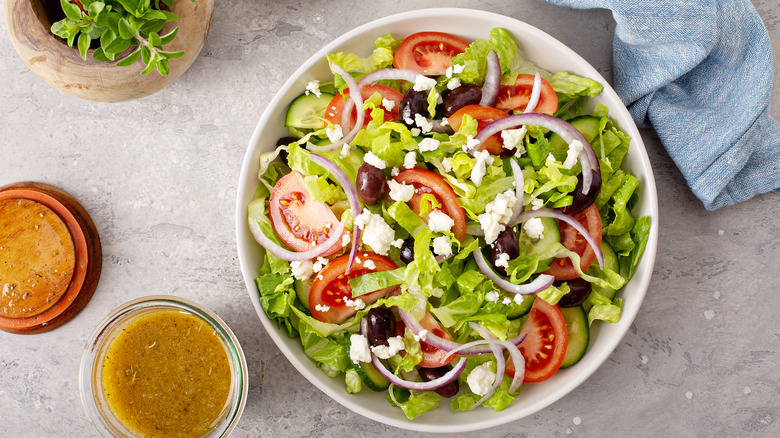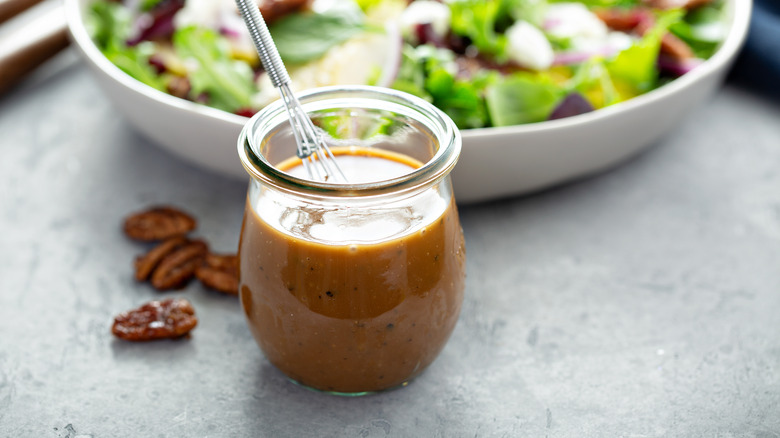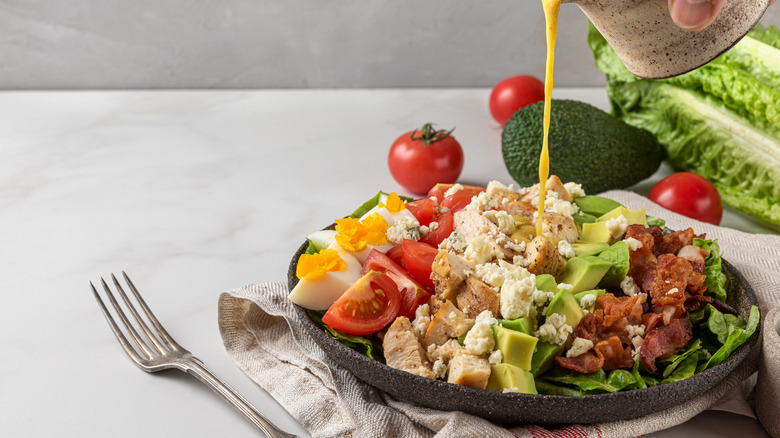Salad Dressing Is The Easiest Way To Use Up Extra Kombucha
If you're looking for kombucha at the grocery store, you certainly won't find it in the salad dressing aisle. It'll be in the refrigerated drink section next to the other healthy beverages, like bottled smoothies, pressed juices, and iced tea. Kombucha, as many people know, is a fizzy, probiotic drink that comes in a variety of fruity flavors. It gets its effervescence from the fermentation of tea combined with sugar, water, and something called scoby — a source of live yeast and bacteria cultures.
The easiest and most common way to take advantage of kombucha's many gut health and immune system benefits is to simply drink it. However this isn't actually the only way to consume the probiotic. Some people turn kombucha into fruit leather or candy, and it can even be used as a marinade, substituted for cooking wine, or made into applesauce. And if you like to make your salad dressing from scratch, kombucha also makes for a tasty vinaigrette.
Turning kombucha into salad dressing
You wouldn't think to add tea or probiotics to a vinaigrette, but acid in the form of lemon juice or vinegar is a main ingredient. So what does this have to do with kombucha? Well, as it turns out, kombucha is not only acidic, but also has a pH level comparable to lemon juice and apple cider vinegar. This acidity is a byproduct of the fermentation process, which is why the tea drink tends to have a tart flavor. It's also why kombucha is the perfect ingredient to use in vinaigrette.
The most basic vinaigrettes consist of only oil and either vinegar or lemon juice, so without one or the other, it's not exactly a vinaigrette. The emulsion of these two components is what causes the dressing to stick to the lettuce leaves and other ingredients while at the same time creating a synergy of flavor. Since it's just as acidic, kombucha functions the same way as vinegar does in vinaigrette.
How much kombucha to use in salad dressing
To use kombucha in a salad dressing, all you have to do is substitute it for the vinegar or lemon juice in your recipe. If you don't have a recipe to go off of, start with a ratio of three parts oil to one part kombucha. From there you can taste as you go, adding more kombucha until you achieve your desired level of acidity.
Keep in mind that while lemon juice and vinegar are fairly straightforward in terms of taste, kombucha comes in flavors like mint, raspberry, strawberry, and watermelon. Choose wisely to avoid any potentially clashing or overpowering tastes; chai or pie spice might be difficult to incorporate unless you're making a roasted autumn harvest salad or something similar. As shared on Instagram, Atlanta-based Golda Kombucha turned its hopped citrus flavor (which also contains CBD) into Italian dressing. But no matter what type of salad you decide to go with, those greens are sure to taste extra vibrant and delicious with the right kombucha-fueled vinaigrette.


